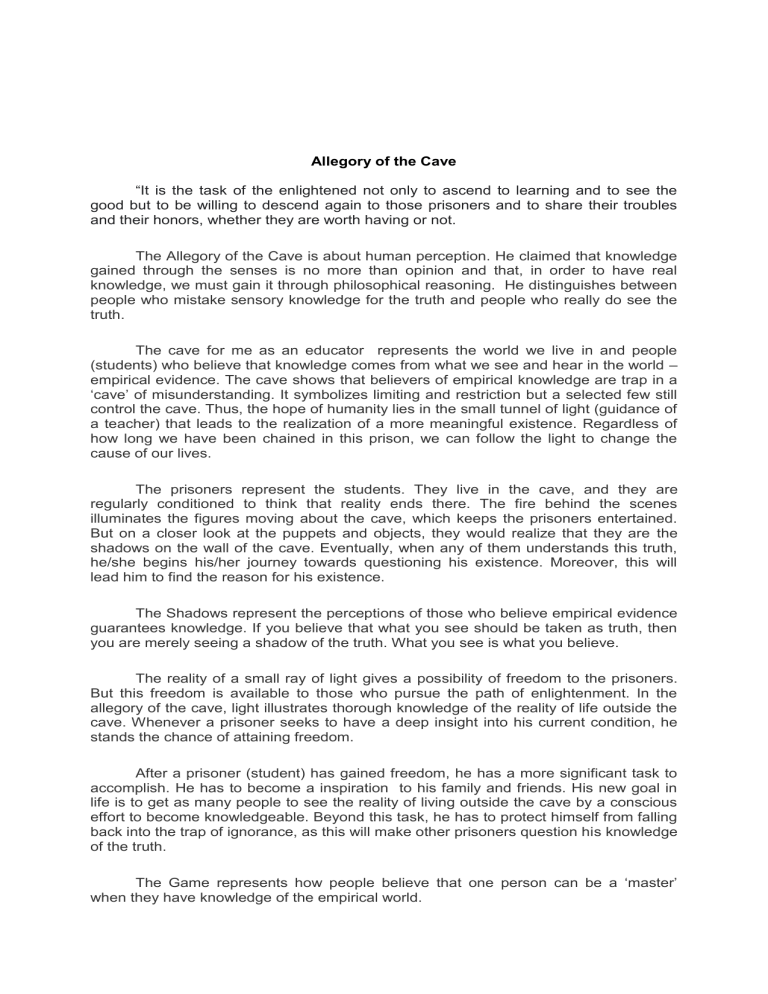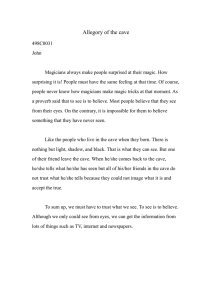
Allegory of the Cave “It is the task of the enlightened not only to ascend to learning and to see the good but to be willing to descend again to those prisoners and to share their troubles and their honors, whether they are worth having or not. The Allegory of the Cave is about human perception. He claimed that knowledge gained through the senses is no more than opinion and that, in order to have real knowledge, we must gain it through philosophical reasoning. He distinguishes between people who mistake sensory knowledge for the truth and people who really do see the truth. The cave for me as an educator represents the world we live in and people (students) who believe that knowledge comes from what we see and hear in the world – empirical evidence. The cave shows that believers of empirical knowledge are trap in a ‘cave’ of misunderstanding. It symbolizes limiting and restriction but a selected few still control the cave. Thus, the hope of humanity lies in the small tunnel of light (guidance of a teacher) that leads to the realization of a more meaningful existence. Regardless of how long we have been chained in this prison, we can follow the light to change the cause of our lives. The prisoners represent the students. They live in the cave, and they are regularly conditioned to think that reality ends there. The fire behind the scenes illuminates the figures moving about the cave, which keeps the prisoners entertained. But on a closer look at the puppets and objects, they would realize that they are the shadows on the wall of the cave. Eventually, when any of them understands this truth, he/she begins his/her journey towards questioning his existence. Moreover, this will lead him to find the reason for his existence. The Shadows represent the perceptions of those who believe empirical evidence guarantees knowledge. If you believe that what you see should be taken as truth, then you are merely seeing a shadow of the truth. What you see is what you believe. The reality of a small ray of light gives a possibility of freedom to the prisoners. But this freedom is available to those who pursue the path of enlightenment. In the allegory of the cave, light illustrates thorough knowledge of the reality of life outside the cave. Whenever a prisoner seeks to have a deep insight into his current condition, he stands the chance of attaining freedom. After a prisoner (student) has gained freedom, he has a more significant task to accomplish. He has to become a inspiration to his family and friends. His new goal in life is to get as many people to see the reality of living outside the cave by a conscious effort to become knowledgeable. Beyond this task, he has to protect himself from falling back into the trap of ignorance, as this will make other prisoners question his knowledge of the truth. The Game represents how people believe that one person can be a ‘master’ when they have knowledge of the empirical world. The escaped prisoner represents the student, who seeks knowledge outside of the cave and outside of the senses. The Sun represents philosophical truth and knowledge. His intellectual journey represents a student journey in finding truth and wisdom. The other prisoners’ reaction to the escapee returning represents those students who are scared coming out of their comfort zone to explore and learn. As a teacher, we must be the light to our students to emphasize the concept of human existence based on knowledge rather than beliefs. Regardless of how long they remain in their cave, we should help them realize that they are solely responsible for discovering the true meaning of their existence. Although they may require assistance to escape from the cave, they must make an effort to gain the freedom that they want.


